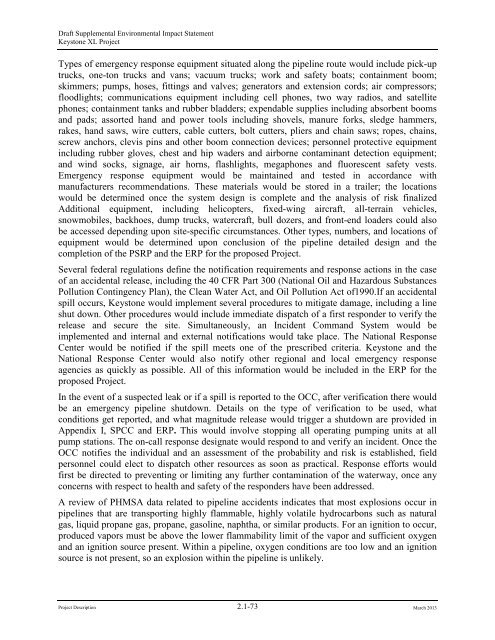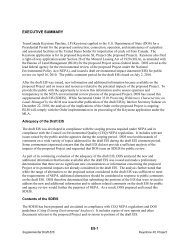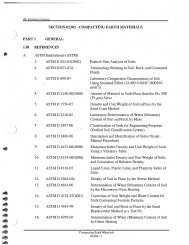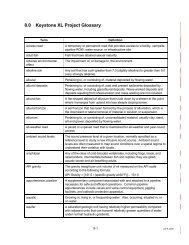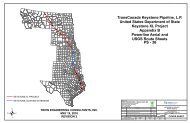2.1 Overview of the Proposed Project - Keystone XL pipeline - US ...
2.1 Overview of the Proposed Project - Keystone XL pipeline - US ...
2.1 Overview of the Proposed Project - Keystone XL pipeline - US ...
You also want an ePaper? Increase the reach of your titles
YUMPU automatically turns print PDFs into web optimized ePapers that Google loves.
Draft Supplemental Environmental Impact Statement<strong>Keystone</strong> <strong>XL</strong> <strong>Project</strong>Types <strong>of</strong> emergency response equipment situated along <strong>the</strong> <strong>pipeline</strong> route would include pick-uptrucks, one-ton trucks and vans; vacuum trucks; work and safety boats; containment boom;skimmers; pumps, hoses, fittings and valves; generators and extension cords; air compressors;floodlights; communications equipment including cell phones, two way radios, and satellitephones; containment tanks and rubber bladders; expendable supplies including absorbent boomsand pads; assorted hand and power tools including shovels, manure forks, sledge hammers,rakes, hand saws, wire cutters, cable cutters, bolt cutters, pliers and chain saws; ropes, chains,screw anchors, clevis pins and o<strong>the</strong>r boom connection devices; personnel protective equipmentincluding rubber gloves, chest and hip waders and airborne contaminant detection equipment;and wind socks, signage, air horns, flashlights, megaphones and fluorescent safety vests.Emergency response equipment would be maintained and tested in accordance withmanufacturers recommendations. These materials would be stored in a trailer; <strong>the</strong> locationswould be determined once <strong>the</strong> system design is complete and <strong>the</strong> analysis <strong>of</strong> risk finalizedAdditional equipment, including helicopters, fixed-wing aircraft, all-terrain vehicles,snowmobiles, backhoes, dump trucks, watercraft, bull dozers, and front-end loaders could alsobe accessed depending upon site-specific circumstances. O<strong>the</strong>r types, numbers, and locations <strong>of</strong>equipment would be determined upon conclusion <strong>of</strong> <strong>the</strong> <strong>pipeline</strong> detailed design and <strong>the</strong>completion <strong>of</strong> <strong>the</strong> PSRP and <strong>the</strong> ERP for <strong>the</strong> proposed <strong>Project</strong>.Several federal regulations define <strong>the</strong> notification requirements and response actions in <strong>the</strong> case<strong>of</strong> an accidental release, including <strong>the</strong> 40 CFR Part 300 (National Oil and Hazardous SubstancesPollution Contingency Plan), <strong>the</strong> Clean Water Act, and Oil Pollution Act <strong>of</strong>1990.If an accidentalspill occurs, <strong>Keystone</strong> would implement several procedures to mitigate damage, including a lineshut down. O<strong>the</strong>r procedures would include immediate dispatch <strong>of</strong> a first responder to verify <strong>the</strong>release and secure <strong>the</strong> site. Simultaneously, an Incident Command System would beimplemented and internal and external notifications would take place. The National ResponseCenter would be notified if <strong>the</strong> spill meets one <strong>of</strong> <strong>the</strong> prescribed criteria. <strong>Keystone</strong> and <strong>the</strong>National Response Center would also notify o<strong>the</strong>r regional and local emergency responseagencies as quickly as possible. All <strong>of</strong> this information would be included in <strong>the</strong> ERP for <strong>the</strong>proposed <strong>Project</strong>.In <strong>the</strong> event <strong>of</strong> a suspected leak or if a spill is reported to <strong>the</strong> OCC, after verification <strong>the</strong>re wouldbe an emergency <strong>pipeline</strong> shutdown. Details on <strong>the</strong> type <strong>of</strong> verification to be used, whatconditions get reported, and what magnitude release would trigger a shutdown are provided inAppendix I, SPCC and ERP. This would involve stopping all operating pumping units at allpump stations. The on-call response designate would respond to and verify an incident. Once <strong>the</strong>OCC notifies <strong>the</strong> individual and an assessment <strong>of</strong> <strong>the</strong> probability and risk is established, fieldpersonnel could elect to dispatch o<strong>the</strong>r resources as soon as practical. Response efforts wouldfirst be directed to preventing or limiting any fur<strong>the</strong>r contamination <strong>of</strong> <strong>the</strong> waterway, once anyconcerns with respect to health and safety <strong>of</strong> <strong>the</strong> responders have been addressed.A review <strong>of</strong> PHMSA data related to <strong>pipeline</strong> accidents indicates that most explosions occur in<strong>pipeline</strong>s that are transporting highly flammable, highly volatile hydrocarbons such as naturalgas, liquid propane gas, propane, gasoline, naphtha, or similar products. For an ignition to occur,produced vapors must be above <strong>the</strong> lower flammability limit <strong>of</strong> <strong>the</strong> vapor and sufficient oxygenand an ignition source present. Within a <strong>pipeline</strong>, oxygen conditions are too low and an ignitionsource is not present, so an explosion within <strong>the</strong> <strong>pipeline</strong> is unlikely.<strong>Project</strong> Description <strong>2.1</strong>-73 March 2013


